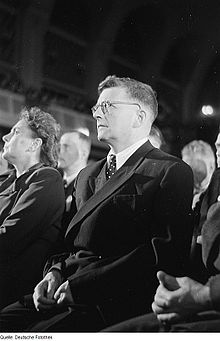This article needs additional citations for verification. (November 2009) |
| Antiformalist Rayok | |
|---|---|
| by Dmitri Shostakovich | |
 Shostakovich in 1950 | |
| Genre | cantata |
| Text | Dmitri Shostakovich |
| Language | Russian |
| Published | 1991 |
| Publisher | Hans Sikorski Musikverlage, DSCH Publishers |
| Duration | 18 minutes |
| Scoring | four basses, mixed choir, piano, and narrator |
| Premiere | |
| Date | 12 January 1989 |
| Location | Kennedy Center Concert Hall, Washington, D.C. |
| Conductor | Mstislav Rostropovich |
| Performers | Julian Rodescu, Eric Halfvarson, Andrew Wentzel, Jonathan Deutsch, Members of the Choral Arts Society of Washington |
Antiformalist Rayok[1] (Russian: Антиформалистический раёк), also known as Learner's Manual, without opus number, is a satirical cantata for four voices, chorus, and piano by Dmitri Shostakovich. It is subtitled As an aid to students: the struggle of the realistic and formalistic directions in music.[2] It satirizes the conferences that resulted from the Zhdanov decree of 1948 and the anti-formalism campaign in Soviet arts which followed it.
The work includes quotations from Andrei Zhdanov's speech at the Conference of the Musicians at the Central Committee of the all-Union Party in Moscow in January 1948. The libretto also incorporates Dmitri Shepilov's speech at the Second Congress of Composers in 1957, in which he mispronounces the name of the composer Nikolai Rimsky-Korsakov (KorSAkov). In regard to music, there are references to the traditional Georgian folk song "Suliko", Joseph Stalin's favourite song, and the popular Russian folk tunes “Kalinka” and “Kamarinskaya”. It also contains musical excerpts from Tikhon Chrennikov's film music True friends and Robert Planquette's operetta Les cloches de Corneville. In addition, the note sequence D–E♭–C–B, the composer's own monogram based on German note names (D–S–C–H), occurs once in the cantata in a different key.[3]
Antiformalist Rayok was not performed publicly during the composer's lifetime. Nonetheless, Shostakovich planned to publish the work in the early 1960s and had intended Opus No. 114 for it. Particularly, the premiere of Symphony No. 13 “Babi Yar” (1962), which had provoked enormous disapproval among the Soviet leadership of the Communist Party (the symphony's song text denounces the Soviet anti-Semitism of the time), was probably the main reason why Shostakovich had not considered publishing his satirical cantata.[4] Antiformalist Rayok was premiered 14 years after the composer's death in 1989.[5]
- ^ Dmitri Shostakovich (PDF). Hamburg: Sikorski Musikverlage Hamburg. 2011. p. 139. Archived (PDF) from the original on 2 August 2020. Retrieved 3 November 2022.
- ^ Hulme, Derek C. (2010). Dmitri Shostakovich: The First Hundred Years and Beyond. Scarecrow Press. pp. 527–529. ISBN 9780810872646.
- ^ MacDonald, Calum (6 September 1990). "The Antiformalist "Rayok" - Learners Start Here!". Tempo. 173 (Jun., 1990): 23–30. doi:10.1017/S0040298200019094. JSTOR 946396. S2CID 144845644 – via JSTOR.
- ^ Yakubov, Manshir (2000). Shostakovich's Anti-Formalist Rayok. A history of the Work's Composition and its Musical and Literary Sources, in: Shostakovich in Context. Oxford University Press: Rosamund Barett. pp. 135–157.
- ^ Sikorski (2011). Dmitri Shostakovich (PDF). Hamburg: Sikorski Musikverlage Hamburg. p. 139. Archived (PDF) from the original on 2 August 2020. Retrieved 19 May 2022.